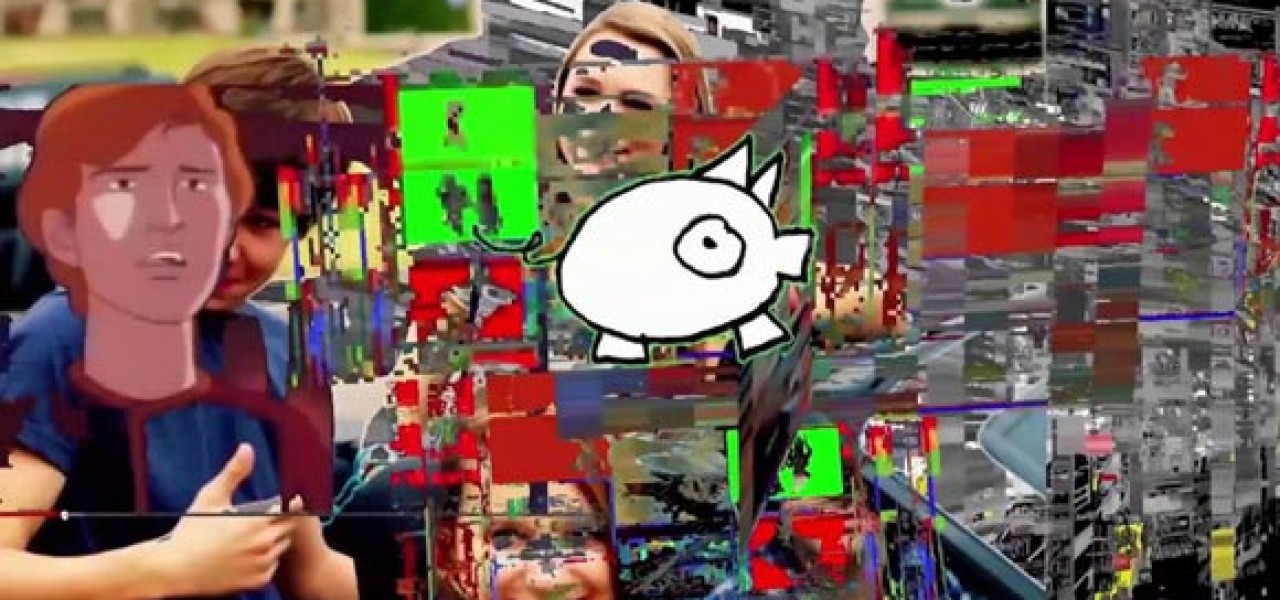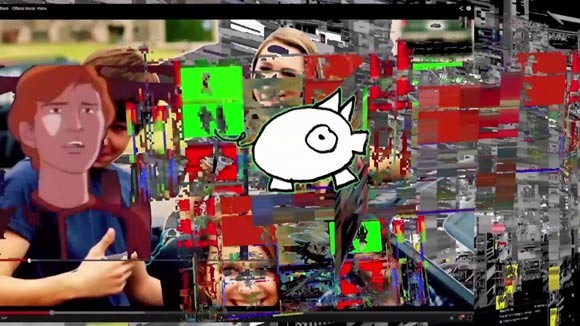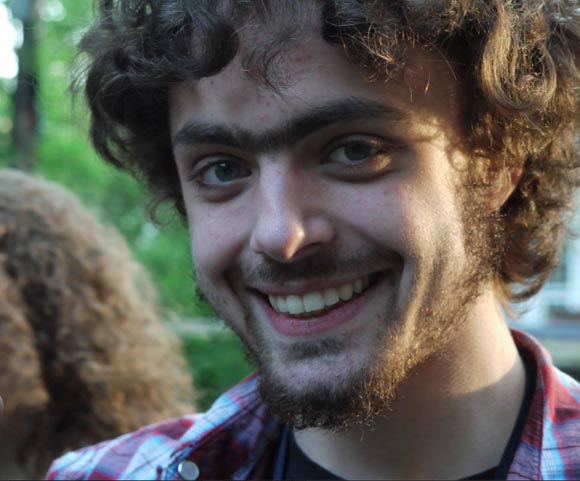

CBTV Student Fest: ‘Mr. Piggy Dies in 25 Dimensions’ by Josh Sehnert
We are excited to launch Cartoon Brew’s fifth annual Student Animation Festival with this year’s grand-prize winning film Mr. Piggy Dies in 25 Dimensions by Josh Sehnert of Rhode Island School of Design.
There are certain things you learn after five years of running a student animation festival, chief among them that the shorter the film, the better. That’s why when you’re in the middle of a marathon viewing session of student films, and a sixteen-minute piece called Mr. Piggy Dies in 25 Dimensions appears next on your playlist, you curse under your breath and let out a deep sigh. What are students thinking nowadays when they make these films?
You decide to watch the first minute of the film. What the hell am I looking at? But, wait a second, there’s a couple other feelings that begin to emerge: shock and laughter. As most students are busy creating slick showreel pieces to garner the attention of big animation studios, this filmmaker is sticking his middle finger at the studios and parodying the insane bombast of Hollywood’s machinery. He implores the viewer to, “Prepare your anus for the movie to justify your miserable existence!” which in so many words is what every Hollywood movie trailer demands of its audience.
After the uplifting 9/11 gag and the twenty-second deconstruction of the Disney logo, we’re finally ready to begin the film, which is an increasingly manic 25-chapter saga of a pig, Mr. Piggy, who dies. If you ever wanted a definition—or a parody—of the New Aesthetic art movement, this is the film you’d show. Sehnert understands that animation and technology are inseperable nowadays, and he makes you aware of the technology behind his images every single step of the way.
The film represents what every student film should aspire to: joyful anarchy that revels in the fact that as a student, you can do anything. You can try everything. Doesn’t matter if it works or fails. Surely, every idea in Mr. Piggy Dies doesn’t succeed. That’s hardly the point. Sehnert experiments. He tries things that you can’t try when you’re a cog in the machine working on a $150 million production because one goof-up and you’re on the unemployment line. Sehnert has a punk attitude that snatches back animation from those who try to mash it into a puréed commercial product for the masses. It’s an attitude that’s all too rare in student films. Another such film that pops to mind is Stephan Flint Müller’s 2004 film Bow Tie Duty for Squareheads. And it’s a difficult trick to pull off successfully unless you actually back it up with skills. Sehnert understands pacing and cutting and storytelling. And he uses everything he’s got to shock us for sixteen rebellious minutes.
Continue reading for comments from the filmmaker Josh Sehnert:

THE IDEA
I made half of Mr. Piggy Dies in the first two weeks of my senior year, and didn’t consider it my degree project until the morning I turned it in. That isn’t to say I didn’t slave over my senior thesis, but I would say only about 15% of that work went into Mr. Piggy Dies in 25 Dimensions.
Most of the year was spent on a project that I had been neurotically developing since high school. I was stubbornly determined that I would produce a pilot episode for an animated sitcom, which I planned to pitch after graduation. Like everything I make, it was relentlessly complicated, overly ambitious, and impossible for me to finish in one year by myself. Yet I worked on it constantly with this blind confidence that I had the production ability of a professional studio. Needless to say, it ended disastrously with an existential crisis that backfired into the manifestation of Mr. Piggy.
Mr. Piggy was created in the first week of my senior year, when we had to create a short film a day, for five days straight. One of these films was titled Mr. Piggy Saves the World and Dies, and is the 13th dimension of the film. Given the limited production time, I decided to use the simplest character possible, and draw everything with just a pencil. It was an exercise in crude efficacy, and I suddenly felt as if I had discovered a breakthrough process.
Based on the work we did this week, our professors gave us an individual prompt and a full week to make another film. My prompt was “25 perspectives”. By the end of the week, the entire film concept was formed and almost half of the dimensions were animated.
I wrote the film though a process of creating one hundred titles in the format of “Mr Piggy_______and dies”. In one writing burst, I had made a huge batch of ways to kill Mr. Piggy. The dialogue came from searching for a tone that was part tongue-in-cheek, yet could cover deep topics while still being funny.
As a character, I wanted Mr. Piggy to be a sympathetic narcissist, out of some kind of lonely desperation to give his life meaning and fulfillment. Given the title and repetition of his death as a constant joke, the inevitability of his demise mixed with his misguided optimism set up the perfect atmosphere for Mr. Piggy’s comedic tragedy to constantly reinvent itself.
TOOLBOX AND PROCESS
I initially wanted every dimension to be animated with a different technique, but ultimately, I simply wanted everything to look and feel like alternate dimensions. My working process was a reflection of my attention deficit disorder. I would go from generating random glitches, to an After Effects disaster, to clay animation, then to scratching 16mm film, to amateur CGI trash, then back to pencil and paper, simply whenever I got bored or distracted by a new idea.
I eventually realized I should be aiming for transgressive approaches that were drastically different from industry standard animation. I started using software and effects in an incorrect or crude manner in search of a distinctive style. Most professional effects aim to be unnoticeable, just like huge-budget CGI tries to emulate real life. I find this to be a hilarious contradiction that causes much of what visually appeals to me in CGI to be hidden from the final product.
Therefore, I aimed to make all the computer animation as self-aware of its medium as possible, incorporating wireframes, CGI jokes, Maya interfaces, and other raw production elements that are hidden underneath polished 3D. There is almost no actual rendering from any of the CGI, all of it was done with QuickTime screen recordings of Maya. This appealed to me because it added a human touch to such a calculated medium; it preserved the cursor and live rotations of the spontaneous, uncalculated movements of mouse inputs.
I wanted a direct use of software that made the rawness of its effects an integral part of the result: a look that was defined by a computer interpreting deliberate human error. Ultimately, I think it successfully made the film look like it shouldn’t logically exist in the first place.
CHALLENGES AND LESSONS LEARNED
I should preface this by saying, I over think almost everything I do, and the real revelation of this film was a blunt rebuttal of this habit. In the end, it was the intuitive, effortless-feeling process of the entire film that allowed it to manifest the way it did.
Really, most of the challenges came when working on my disastrous pilot episode, and it was a test for me to keep those problems out of the process of Mr. Piggy. I had been re-writing scripts constantly, had characters that were difficult to write for and draw repetitively, and kept adding more ideas when not enough was complete in the first place, a perfect recipe for a project to never finish itself.
In contrast, Mr. Piggy was so simple to execute. The ideas flowed freely because they did not have to narrowly fit into an over-developed concept. It was an “Anything goes” approach. I had to learn these lessons though my other developments, in order to take an opposing approach with Mr. Piggy. It makes perfect sense to me that an anti-professional industry satire would be the mutated byproduct of my frustrated attempt to handle the work of a whole studio. It wasn’t until I stopped trying to do what only a studio could, that I did what a studio would never do in the first place.
The most important lesson, ultimately, was in order to make something brutally spontaneous; you have to let action dominate thought. You can’t constantly think, “Could this be developed more,” or you’ll have something that will never be done. You have to let dumb weird ideas come naturally and compile until you have content to choose from. And often, it’s the strangest, craziest ideas that work.
INSPIRATIONS
I like laughing at cute things getting killed. I was one of those disturbed children who would cry tears of joy during Happy Tree Friends. I’m generally a fan of anything completely screwed up and dark. I grew up with South Park, and picked up on the correlation between its spontaneity and its simple and effective animation style. I’ve always been a huge fan of the absurd, twisted humor of David OReilly and Don Hertzfeldt, taking note of how they can work in bulk with a stripped-down style that has its own idiosyncratic appeal.
Another important factor is how I listen to bombastic Hollywood trailer music to get inspired. I realized that this inspirational quality is what sells movies. Then I got this idea that I could use this music in a fake trailer, and then show a bunch of completely random clips, causing viewers to imagine they are linearly connected into a story because of how we’re conditioned to perceive trailers. To me, the funniest aspect is the clash of production value between the crude animation and the high-budget promotional elements. I found a lot of humor in making it seem as if Hollywood was trying to sell something really stupid and bizarre using epic music to compensate for quality.
WHERE YOU SEE YOURSELF IN FIVE YEARS
After forming a guerilla animation studio and amassing a gigantic market of consumer slaves, I plan to further brainwash humanity by distributing more Mr. Piggy media propaganda in the form of toys, video games, canned meats, individually-wrapped slices, made-for-DVD sequels and collectable, limited edition Blu-ray re-mastered re-releases in order to amass power by capitalizing on the hearts, minds, and sprits of children and their families! If this all proves that people will never tire of Mr. Piggy’s death, then my idea overflow of murder methods will translate into a feature length, Mr. Piggy Dies in 125 Dimensions!
Meanwhile, after I complete my “impossible to finish” pilot episode, I want to direct my horrible cartoon show, which is called MeatHouse! It’s about a despicable talking pig family that live in a dystopic future where the United States is a capitalist-dictatorship run by super-corporations. It will be a devastating assault on traditional human values and social decency. Hopefully enough horrible people will be sufficiently amused by it to consume it on a dietary basis!
But for now, my lingering frustrations have inspired me to explore an experimental music genre called drone metal, which I find to be a more instantaneous way of being unbearably loud and annoying. If I can handle all of this in five years, then I’ll build a theme park and form my own nation, or something.

.png)